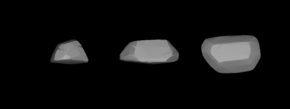
327 Columbia is a stony asteroid from the middle region of the asteroid belt, approximately 26 kilometers in diameter. It was discovered on 22 March 1892, by French astronomer Auguste Charlois at Nice Observatory in southeast France. It is named after Christopher Columbus (1451–1506).
1313 Berna, provisional designation 1933 QG, is a background asteroid and synchronous binary system from the Eunomian region in the central asteroid belt, approximately 14 kilometers in diameter. It was discovered on 24 August 1933, by Belgian astronomer Sylvain Arend at the Uccle Observatory in Belgium. The assumed S-type asteroid has a longer-than average rotation period of 25.5 hours and is likely elongated in shape. It was named for the Swiss capital of Bern. The discovery of an 11-kilometer-sized companion was announced in February 2004.
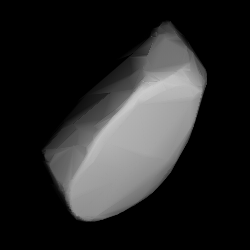
1219 Britta, provisional designation 1932 CJ, is a stony background asteroid from the inner regions of the asteroid belt, approximately 11 kilometers in diameter. It was discovered on 6 February 1932, by German astronomer Max Wolf at the Heidelberg-Königstuhl State Observatory in southern Germany. The likely elongated S-type asteroid has a rotation period of 5.57 hours. Any reference of its name to a person is unknown.
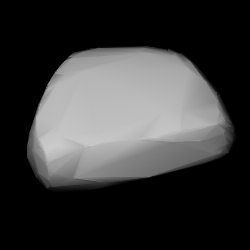
4492 Debussy is a dark and elongated background asteroid and binary system from the intermediate asteroid belt, approximately 15 kilometers in diameter. It was discovered on 17 September 1988, by Belgian astronomer Eric Elst at Haute-Provence Observatory in France. It was later named after French composer Claude Debussy.
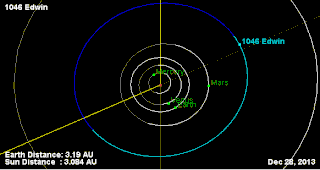
1046 Edwin, provisional designation 1924 UA, is a background asteroid from the outer regions of the asteroid belt, approximately 30 kilometers kilometers in diameter. It was discovered on 1 December 1924, by Belgian–American astronomer George Van Biesbroeck at the Yerkes Observatory in Wisconsin, United States, who named it after his son, Edwin Van Biesbroeck. The potentially metallic asteroid has a short rotation period of 5.29 hours.
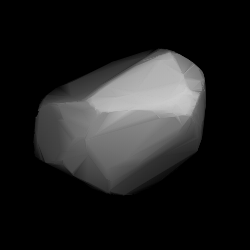
1088 Mitaka is a bright background asteroid from the inner regions of the asteroid belt. It was discovered on 17 November 1927, by Japanese astronomer Okuro Oikawa at the old Tokyo Astronomical Observatory in Japan. The stony S-type asteroid has a notably short rotation period of 3.0 hours and measures approximately 15 kilometers in diameter. It was named after the Japanese village of Mitaka.

1095 Tulipa is an Eos asteroid from the outer regions of the asteroid belt. It was discovered by German astronomer Karl Reinmuth at the Heidelberg-Königstuhl State Observatory in southwest Germany on 14 April 1926. The assumed S-type asteroid has a rotation period of 2.8 hours and measures approximately 30 kilometers in diameter. It was named after the flower Tulip. Originally, the name was redundantly assigned to Florian asteroid 1449 Virtanen.

1140 Crimea, provisional designation 1929 YC, is a stony asteroid from the middle region of the asteroid belt, approximately 28 kilometers in diameter. It was discovered on 30 December 1929, by Soviet astronomer Grigory Neujmin at Simeiz Observatory on the Crimean peninsula, after which it was named.
2751 Campbell, provisional designation 1962 RP, is a stony Nysian asteroid from the inner regions of the asteroid belt, approximately 6 kilometers in diameter.
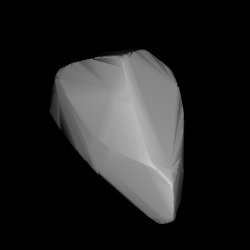
1349 Bechuana, provisional designation 1934 LJ, is a background asteroid from the outer regions of the asteroid belt, approximately 26 kilometers in diameter. It was discovered on 13 June 1934, by South-African astronomer Cyril Jackson at the Union Observatory in Johannesburg. The asteroid was named for the former Bechuanaland, what is now the Republic of Botswana.
3960 Chaliubieju, provisional designation 1955 BG, is a stony asteroid from the central regions of the asteroid belt, approximately 9 kilometers in diameter. It was discovered on 20 January 1955, by astronomers at the Purple Mountain Observatory in Nanjing, China. The asteroid was named after Cha Liubieju, a friend of one of the discoverers.
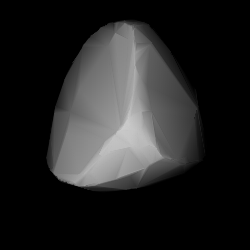
1328 Devota, provisional designation 1925 UA, is a dark background asteroid from the outermost regions of the asteroid belt, approximately 56 kilometers in diameter. It was discovered on 21 October 1925, by Russian–French astronomer Benjamin Jekhowsky at the Algiers Observatory in North Africa. The asteroid was named after Argentine astronomer Fortunato Devoto.

1251 Hedera is a background asteroid from the central regions of the asteroid belt, approximately 13 kilometers in diameter. It was discovered on 25 January 1933, by German astronomer Karl Reinmuth at the Heidelberg-Königstuhl State Observatory in southwest Germany. The asteroid was named for the climbing plant Hedera, commonly known as "ivy".
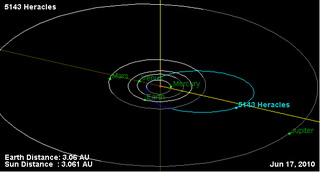
5143 Heracles(provisional designation 1991 VL) is a highly eccentric, rare-type asteroid and synchronous binary system, classified as near-Earth object of the Apollo group, approximately 4.8 kilometers in diameter. The asteroid was discovered on 7 November 1991, by American astronomer Carolyn Shoemaker at Palomar Observatory in California, United States. It is named for the Greek divine hero Heracles. It has an Earth minimum orbit intersection distance of 0.058 AU (8.7 million km) and is associated with the Beta Taurids daytime meteor shower.
1176 Lucidor, provisional designation 1930 VE, is a carbonaceous background asteroid from the central region of the asteroid belt, approximately 30 kilometers in diameter. It was discovered by Eugène Delporte in 1930, who named it after a friend.
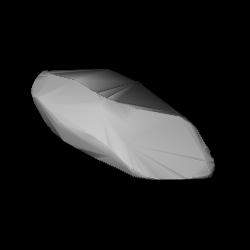
2094 Magnitka (prov. designation: 1971 TC2) is a Flora asteroid from the inner regions of the asteroid belt, approximately 12 kilometers (7.5 miles) in diameter. It was discovered on 12 October 1971, at and by the Crimean Astrophysical Observatory in Nauchnyj, on the Crimean peninsula. The discovery has not been attributed to an observing astronomer. It was later named for the city of Magnitogorsk.
1392 Pierre, provisional designation 1936 FO, is a dark, dynamical Eunomian asteroid from the central regions of the asteroid belt, approximately 26 kilometers (16 mi) in diameter. It was discovered on 16 March 1936, by astronomer Louis Boyer at the Algiers Observatory in Algeria, North Africa. The asteroid was named after the discoverer's nephew, Pierre.
7776 Takeishi, provisional designation 1993 BF, is a background asteroid from the inner regions of the asteroid belt, approximately 6 kilometers in diameter. It was discovered on 20 January 1993, by Japanese astronomer Takeshi Urata at the Nihondaira Observatory in Japan. The assumed S-type asteroid has a rotation period of 8.9 hours. It was named after Japanese amateur astronomer Masanori Takeishi.

1336 Zeelandia, provisional designation 1934 RW, is a stony Koronian asteroid from the outer regions of the asteroid belt, approximately 21 kilometers in diameter. It was discovered on 9 September 1934, by Dutch astronomer Hendrik van Gent at the Union Observatory in Johannesburg, South Africa. The asteroid was named for the Dutch province of Zeeland.

1407 Lindelöf, provisional designation 1936 WC, is an asteroid from the central region of the asteroid belt, approximately 20 kilometers in diameter. It was discovered on 21 November 1936, by Finnish astronomer Yrjö Väisälä at Turku Observatory in Southwest Finland. The asteroid was named after Finnish topologist Ernst Lindelöf.
